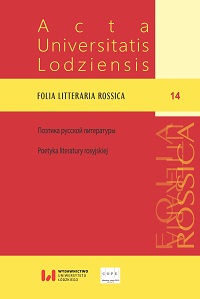Birds’ Eden: Birds of Paradise in Early Modern Russian Culture
DOI:
https://doi.org/10.18778/1427-9681.14.02Keywords:
bird of paradise, high culture and folk culture, Modern Times, the Garden of Eden topos, eclecticismAbstract
The article discusses the model of synthesising literary images (eclecticism) with reference to the history of birds of paradise in Early Modern Russia. In medieval Russian books, legendary birds (Sirin, Alkonost, Phoenix, Gamayun, etc.) are depicted and described with their individual characteristics. Some of them have human features (anthropomorphism), others have no legs and never sit on the ground; some can heal, others can be reborn; some fascinate with their singing, others control the elements. In medieval culture, the images of these miraculous birds almost never merge. In the Early Modern Russian culture, a new “bird pantheon” is being created, the representatives of which are united on a twofold basis: external splendour and special properties of voice. The pantheon includes both characters of medieval legends and real-life birds, especially exotic ones, with which the Russian people begin to get acquainted then, mixing truth and fiction in stories about them. Birds of the “paradise pantheon” replace each other and are being combined. The symbolic paradise in folk culture becomes a space in which their various features are permitted to interact. The hyperbolisation of brightness, beauty and magical properties is perceived in this context as natural and harmonious, and various birds, getting into the “pantheon”, lose their individual characteristics and acquire features of their “neighbours”. In a drawing a parrot is called a peacock. A canary and a parrot in a wood carving look like a rooster. Gamayun and Alkonost become anthropomorphic (like Sirin) and acquire peacocks’ tails. The Sirin’s images bear the inscription “Pharaoh”, because the siren (sirena) is called “faraonka” in the Russian culture. However, the same eclecticism of images and features receives an ironic interpretation in fables and journalistic genres of the 18th century. The enumeration of beauties and wonders turns into grotesque, the multiplication of birds’ names, where a peacock and a crow, a parrot and an eagle appear alongside, leads to ridiculing the overall image. The parrot and the raven can replace each other in different translations of a fable because both of them have the ability to speak, but the expectation of a beautiful singing from the crow is a subject of a comic story. Alexander Shishkov enhances the confusion, naming not only well-known allegories (the parrot as a stupid chatterbox and imitator; a crow in peacock’s feathers), but also turning the narrative (a peacock in a crow’s feathers). Beautiful and great things become comic and ridiculous in the new culture, but remain relevant in modern kitsch.
Downloads
References
Azbukovnik. RGB. F. 299, sobranie N. S. Tikhonravova, No. 1.
Google Scholar
Belova, Olga V. Slavyanskii bestiarii: slovar nazvanii i simvoliki. Moskva: Indrik, 2001.
Google Scholar
Bobrinskii, Aleksandr A. Narodnye russkie derevyannye izdeliya: predmety domashnego, khozyaistvennogo i otchasti tserkovnogo obikhoda. Moskva: Izdatelstvo V. Shevchuk, 2014.
Google Scholar
Chernyi, Valentin D. Russkie srednevekovye sady. Opyt klassifikatsii. Moskva: Rukopisnye pamyatniki Drevnei Rusi, 2010.
Google Scholar
Fiziolog Damaskina Studita. RGB. F. 310, sobranie V. M. Undolskogo, No. 688.
Google Scholar
Kimyagarova, Roza S. ‘Mudrets igrivyi i glubokii’. Krylov-basnopisets: sbornik statei. Moskva: MAKS Press, 2020.
Google Scholar
Kniga glagolemaya estestvoslovnaya. RGB. F. 68, sobranie Generalnogo shtaba, No. 6743.
Google Scholar
Makhov, Aleksandr E. Emblematika. Makrokosm. Moskva: Intrada, 2014.
Google Scholar
Matasova, Tatyana A. “Popugai v Moskve v 1490 godu”. Rus, Rossiya: Srednevekove i Novoe vremya. No. 6 (2019): 126–129.
Google Scholar
Sakharov, Vsevolod I. “Russkaya masonskaya poeziya XVIII veka (k postanovke problemy)”. Russkaya literatura 1995, No. 1 (1995): 3–26.
Google Scholar
Shishkov, Aleksandr S. Rassuzhdenie o starom i novom sloge rossiiskogo yazyka http://az.lib.ru/s/shishkow_a_s/text_1803_rassuzhdenie_o_starom.shtml
Google Scholar
Sumarokov, Aleksandr P. Vorona i lisa https://rvb.ru/18vek/sumarokov/01text/01versus/17parables/134.htm
Google Scholar
Tarkovskii, Rostislav B., Tarkovskaya, Lana R. Ezop na Rusi. Vek XVII: issledovaniya, teksty, kommentarii. Sankt-Peterburg: Dmitrii Bulanin, 2005.
Google Scholar
Vakar, Lyudmila V. Raspisnye kovry Belarusi: mezhdu malyarnym remeslom i massovoi kulturoi. In: Naivnoe iskusstvo i kitch: osnovnye problemy i osobennosti vospriyatiya, ed. N. A. Musyankova. Sankt-Peterburg: Aleteiya, 2019: 81–93; vkleika l. 5 ob–6.
Google Scholar
Vondel, Joost van. De complete werken van Joost van Vondel https://www.litres.ru/joost-van-devondel/de-complete-werken-van-joost-van-vondel-2/chitat-onlayn/
Google Scholar












